John Hurrell – 22 November, 2016
Carefully installed in the Len Lye Centre so that pertinent aspects of the current work easily resonate with Lye's historic contributions, the various cross connections soon become obvious to the attentive visitor. There is a lovely suite of ongoing ‘conversations' at play here. Actually ‘lovely' sounds a bit tame. This show - as a group of works by invited artists - is brilliant.
New Plymouth
Len Lye, Ross Manning, Žilvinas Kempinas, Rebecca Baumann, Taree MacKenzie
Set in Motion
Curated by Sarah Wall
3 September - 27 November 2016
A group show centred around the exuberant and popular 1952 Len Lye film Colour Cry, and also his whirling black and white ‘harmonic’ Zebra (1965, reconstructed 2009), the four other (mainly Australian) contemporary artists - organised by assistant Len Lye curator Sarah Wall - draw out Lye’s love of transparent saturated colour, dancing pattern and ‘spontaneous’ movement. Carefully installed in the Len Lye Centre so that pertinent aspects of the current work easily resonate with Lye’s historic contributions, the various cross connections soon become obvious to the attentive visitor. There is a lovely suite of ongoing ‘conversations’ at play here. Actually ‘lovely’ sounds a bit tame. This show - as a group of works by invited artists - is brilliant.
Most Lye enthusiasts I think would agree that Colour Cry is a particularly striking work, a favourite film that is haunting aurally with Sonny Terry’s voice and harmonica, and danceable visually with the rolling diagonal columns of coloured bands leaping about, and various gorgeous patterns and textures. However Lye is a particularly physical artist and here (unusually) the projection is too small. (It uses a real - nondigital - projector for the 16mm film, and that projector almost upstages the film, becoming a freestanding sculpture.) The projection is big enough to allow connections with other works to be made palpable intellectually, but it doesn’t ‘cook’ bodily like it ought to. Much of its potential for creating pleasure is lost. Visitors not familiar with Lye’s work might be mystified.
I’ve gone on about this, yet all is not lost. Not remotely. Rebecca Baumann‘s Once More with Feeling is a wonderfully joyous companion for Colour Cry, with its linear array of 37 revolving vertical prisms scattering colour beams split off (from a solitary carefully angled theatre spot) to hit opposite walls. Craftily positioned so that diffuse rainbow hues (three combinations in sequence) go through the doorway of its small room to hit the same wall beyond as the projected Colour Cry rectangle, this is clever curating and feasibly the rationale for Colour Cry‘s projection and scale.
Another clever incorporation is Taree MacKenzie’s Black Line Formation, which uses a live video of a black balsa maquette (a witty allusion perhaps to the Australian sculptor Robert Klippel) rotating on a turntable with a white lightbox as a backdrop. The effect is that three dimensional space is flattened out when the image appears in isolation on the monitor. This makes separate - but visually overlapping - diagonals blend together and reference Colour Cry‘s faster staccato rhythms.
Ross Manning’s configuration of six varieties of overhead projector, all aiming beams of changing coloured light into the long vertical crease of the high-ceilinged gallery’s corner, is also an inspired choice. Each machine is accompanied by two rollers which turn a suspended loop of Sellotaped strips of transparent gel, ensuring its flickering projection slowly spreads, oscillates and mingles with others on the same or opposite wall.
Another work which references the film loop of Colour Cry (and kinetic works like Lye’s Universe) is Žilvinas Kempinas’s O2, a dancing loop of magnetic tape that stays hovering in front of a spot-lit wall, held in place by draughts generated by a carefully aimed fan. Extraordinary because of its stability (no furtive threads, no trick magnets) this work is mesmerising, yet apparently simple. It relies on careful control of all air currents and ventilation within the local space, and is an absolutely compelling contribution.
Zebra is a kinetic Lye sculpture I’ve never seen before, one that is indebted to Gabo with its spinning flexible rod that gradually changes the divisions of its vertical shape. Linked to other Lye works like Blade, Water Whirler, Roundhead and Rotating Harmonic, it is attached (asymmetrically positioned) to a round cam turning at its base, where the vertical rod is not in the middle of the disc but to one side, near the edge. This causes the lower part of the stem to move so that its flexibility creates two different sorts of harmonic pattern higher up, according to its speed (See images). The bleary optical effects and feral patterns are not as spatially subtle as those in MacKenzie’s slower Black Line Formation, but frenetically more akin to some of Lye’s black and white scratch films like Particles in Space and Free Radicals.
Wall’s dynamic, tightly-knit group show is quite special. Her use of contemporary Australian and Lithuanian artists here to recontextualise Lye’s ideas is amazingly successful. As intended, it revitalises his art historical relevance.
John Hurrell
Recent Comments
John Hurrell
Great obit on the fabulous Evan Webb... https://www.stuff.co.nz/taranaki-daily-news/132664100/unsung-effort-how-one-artist-put-aside-his-own-aspirations-to-realise-the-dreams-of-another
John Hurrell
Yesterday morning, Evan Webb--the Len Lye Foundation Director, the man who researched the archives studying Lye's intentions, and who supervised ...
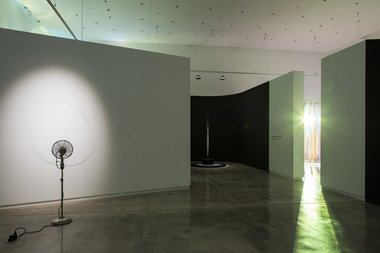
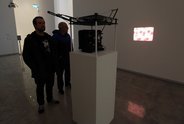
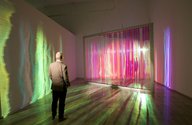
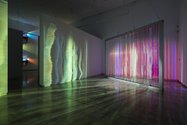
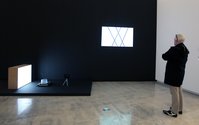
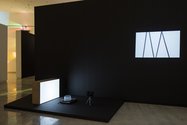
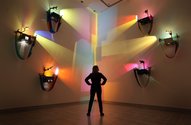
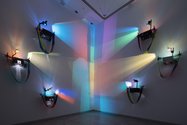
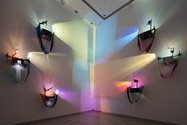


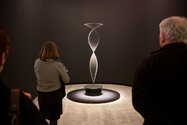
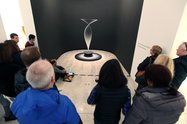
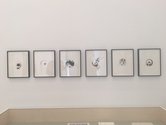
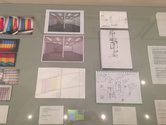
 Two Rooms presents a program of residencies and projects
Two Rooms presents a program of residencies and projects Advertising in this column
Advertising in this column



This Discussion has 2 comments.
Comment
John Hurrell, 1 p.m. 22 May, 2023 #
Yesterday morning, Evan Webb--the Len Lye Foundation Director, the man who researched the archives studying Lye's intentions, and who supervised and built the posthumous kinetic sculptures--died at home of cancer; after a long battle.
Loved by many in the normally fractious art world, for his intellectual rigor, integrity, practical skills and convivial generosity, Evan was a man of great charm and decency who managed to persuade experts in disciplines like engineering to contribute to the construction of the sculptures--when needed. He personally installed many of these works in international group and solo exhibitions around the world.
Always passionately interested in sculpture that moved, and with a great sense of humour, Webb also made portable satirical kinetic works himself, and exhibited them as part of ANZART-IN-HOBART in a streetfront-window gallery in 1983.
John Hurrell, 2:04 a.m. 13 August, 2023 #
Great obit on the fabulous Evan Webb... https://www.stuff.co.nz/taranaki-daily-news/132664100/unsung-effort-how-one-artist-put-aside-his-own-aspirations-to-realise-the-dreams-of-another
Participate
Register to Participate.
Sign in
Sign in to an existing account.